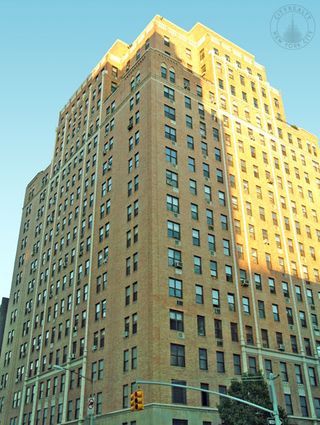 Carter Horsley
Carter HorsleyJan 28, 2016
Carter's Review
This very handsome, 19-story, light-orange-brick apartment building at 161 West 16th Street on the northeast corner at Seventh Avenue in Chelsea was erected in 1930. It has 155 cooperative apartments.
It was built by Henry Mandel who in 1930 purchased a site from Otto H. Hahn on 57th Street between Eighth and Ninth Avenues that had been considered as a site for the Metropolitan Opera and where Mr. Mandel erected the four-building Park Vendome apartment complex.
This Chelsea building was designed by Farrar & Watmough, who also designed Mr. Mandel’s massive London Terrace residential complex in Tuscan-style, red-brick between 23rd and 24th Streets and Ninth and Tenth avenues. When it was built the elegant complex was considered to be the largest apartment complex in the world with 1,670 units.
Mr. Mandel also owned much of the stretch on Seventh Avenue south of 23rd Street to 15th Street on land assembled by A. E. Lefcourt, who had planned a 1,000-foot-high tower in on 42nd Street.
Mr. Mandel built Chelsea Corners, four similar 19-story apartment buildings on Seventh Avenue between 15th and 16th Streets, on which this building is one. They were part of a “visionary plan,” according to a May 23, 2004 “Streetscapes” column in The New York Times by Christopher Gray, noting that “it’s a pity Mandel began the project just before the Depression.”
When Mandel began acquiring properties on 7th Avenue they were “miscellaneous old structures,” according to Mr. Gray.
In the 1980’s, the lower four floors of this building’s frontage on the avenue was taken over by Barney’s. More recently, that space was taken over by Loehman’s and quite recently Barney’s, whose main store in on Madison Avenue at 61st Street, announced that it would once again occupy the space.
Bottom Line
Part of Henry Mandel’s Chelsea Corners plan, this handsome pre-war apartment building is one of the handsomest in Chelsea after his great London Terrace complex several blocks to the north.
Description
The building has a two-story limestone base and full bandcourses above the second and the 14th floors and partial bandcourses above the fourth and the 17th floors.
The building has some setbacks.
Amenities
The building has a landscaped roof deck, a full-time doorman, a live-in superintendent, and a bicycle room.
Apartments
Apartment 19G is a two-bedroom unit with a 19-foot-long entry foyer that leads to a 22-foot-wide living room with a wood-burning fireplaces and a dining alcove next to an enclosed kitchen.
Apartment 17A is a two-bedroom unit with a 12-foot-wide entry foyer that leads to a 21-foot-long living room that opens onto a 56-foot-long east terrace and a 19-foot-long south terrace and a 14-foot-wide enclosed kitchen.
Apartment 17G is a two-bedroom unit with an 18-foot-long entry foyer that leads to a 22-foot-long living room with a wood-burning fireplace and a 32-foot-wide terrace, and an enclosed 17-foot-wide kitchen.
Apartment 5H is a one-bedroom unit with a 9-foot-long entry foyer that leads to a 20-foot-long living room with a small home office and an enclosed 9-foot-wide kitchen.
Apartment 6J is a studio unit with a 21-foot-long living room.
History
“Mandel was part of a new housing movement in New York City,” Mr. Gray wrote, “that built smaller, efficient dwellings in large complexes for white-collar employees who wanted to live close to work and would trade a prestige neighborhood for transit convenience. He also sought to remake the neighborhood by dominating one stretch of real estate with complementary structures, and he planned a separate building with meeting rooms and sports facilities. The first element of Chelsea Corners was completed in late 1930, the 18-story-high 200 West 16th Street. With nine apartments per floor, it was heavily marketed to singled and working couples…Like other such buildings, 200 West 16th had space-saving Murphy beds, but with a twist: instead of folding down from a false doorway, they pivoted around on a track from an oversize clothes closet and then unfolded to the floor.”
“The building at 200 West 15th Street,” Mr. Gray continued, “has some chunky, Assyrian-style ornament with Romanesque details. But the buildings at 161 West 16th Street and 201 West 16th have nice vaulted ceilings and polychromed tile decoration, but the one at 161 West 16th got what was probably thought to be an ‘Art Deco’ makeover perhaps 15 years ago. Three of the four buildings have replaced their steel casement windows with common one-over-one aluminum windows, which serve to deaden the liveliness that Farrar & Watmough sought to impart. But the co-op at 201 West 16th Street has bucked the trend of the lowest common denominator and has just finished installing near-replicas of the original steel casement windows.”
At around the same time, Mr. Mandel building the elegant Lombardy apartment hotel at 111 East 56th Street and the handsome Pershing Square office building on the southeast corner of Park Avenue and 42nd Street.
In 1932, however, he was forced to file for bankruptcy and he died in 1942.

- Co-op built in 1930
- Located in Chelsea
- 155 total apartments 155 total apartments
- 10 recent sales ($610K to $1.3M)
- Doorman
- Pets Allowed
 6sqft delivers the latest on real estate, architecture, and design, straight from New York City.
6sqft delivers the latest on real estate, architecture, and design, straight from New York City.
